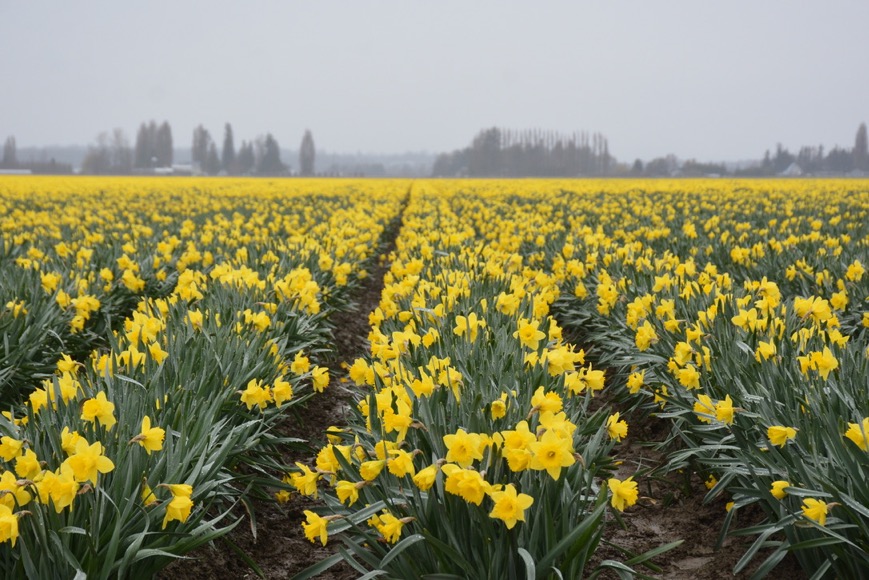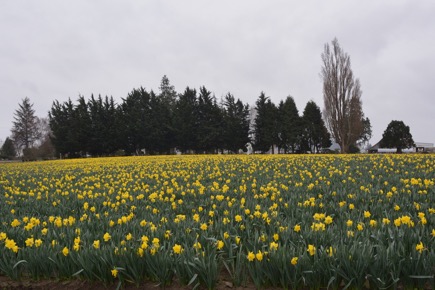Farming flowers
22/03/21 02:07

It was raining, but we took a short drive after church yesterday. I wanted to take a few pictures of the daffodils in the fields, even though we lacked bright sunshine for the iconic yellow flowers. There is a series of country roads just west of town that are labeled “Tulip Route.” They guide viewers near some of the larger nurseries and fields filled with flowers. It is too early for the tulips to be in bloom. That event will crowd the roads and some of the bigger tulip farms are already announcing that they will require reservations for viewing and picture-taking to allow for social distancing and to give viewers an opportunity to take their pictures without other tourists in the background. There were no crowds yesterday. We started our journey at a farm we have visited before, where we purchased tulip bulbs as gifts for family members. Planting tulips was an Advent activity for our grandchildren and they can now see the plants emerging from their garden.
Back in the late ‘70s we visited tulip farms in The Netherlands during a visit to Europe, but I had never given much thought to flowers as a cash crop. I don’t remember that those fields were as large as the ones we viewed yesterday. There is something striking about large four-wheel-drive tractors in a field of flowers. It stirred memories of Dakota sunflower fields and the brief bloom of buckwheat, but this was even more dramatic. Sunflowers are grown for their seeds, mostly for oil seeds. A few farms raise confectionary seeds as well. Buckwheat is harvested as a grain. The daffodil and tulip fields are producing flowers for market and bulbs to be sold as landscaping items. The flowers and bulbs are shipped around the country from Skagit County. I haven’t yet seen them harvest the flowers, but the bulbs are dug with machines similar to potato and onion pickers.
Recently I had a conversation with our librarian and part-time farmer son who has done quite a bit of research on how to produce profit from a small acreage. One of the crops he is considering is dahlias. He grew dahlias at their previous home as flowers to attract pollinators and for the beauty of the blossoms. We’ve seen a couple of small stands selling dahlias and we can remember seeing dahlias for sale at the local farmers market last summer. What they call dahlia bulbs are actually tubers. They require a soil temperature of about 60 degrees, so they are planted in the late spring and dug up in the fall. They can be grown from seed, but local gardeners have a much more stable crop and are more pleased with the results of plants grown from tubers.
Dahlia plants produce many tubers. It is not uncommon to get a fourfold or fivefold harvest in a single year. The going rate for dahlia tubers around here is $5 per tuber. If you start with a modest investment, say $50, and carefully harvest the tubers in the fall and replant in the spring, you could produce enough to earn a couple of thousand dollars by the second or third year. As farming goes, that’s a pretty good return on investment.

I was, however, writing about dahlias. Dahlias are indigenous to Central America. It is the national flower of Mexico and they are common throughout the region down to Costa Rica and Panama. Dahlias have been grown as a food plant. The tubers are fairly high in fructose and are cooked and eaten like potatoes in some places. The plant also has a rich history as a medicinal plant. Among the life-saving drugs that was administered to my wife after a drug reaction produced heart failure was Digoxin. Digoxin strengthens the force of the heart beat and is one of the older drugs used to treat irregular heart rhythms including atrial fibrillation. It was one of the drugs that worked and was safe for my wife. Prior to the discovery of Digoxin, dahlia tubers were used as a treatment for diabetes. Because the tubers are high in fructose, the body is able to use its energy more efficiently than some other carbohydrates. It was believed that eating the tubers stimulated insulin production, but it is not generally used as a treatment for diabetes these days with the discovery of more efficient treatments.
It remains to be seen if our son will produce a crop of dahlias for tuber sale. He has been successful producing flowers for their beauty and to attract bees and other pollinators. This spring, with a new place and new farming adventures to explore, I think a small patch of dahlias will be in order. He has tubers from last year’s crop and has ordered a small amount of additional ones.
I like the idea of flower farming and am fascinated to live in a place where they grow flowers for profit. I’m sure there will be plenty more afternoon drives through the fields to watch the process of growing and harvesting bulbs and tubers.
My father was a John Deere tractor dealer. Both our son and our daughter own John Deere lawn and garden tractors. Maybe our son will invest some of his earnings from his dahlias in a larger tractor one day. Maybe he’ll let me drive it from time to time. Don’t expect large acreages of daffodils and four-wheel-drive monsters, but a flower garden and a little tractor might be just right for a retired preacher who has nostalgia for the days when he was a boy.
